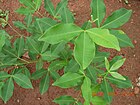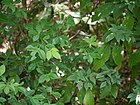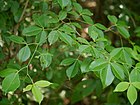Note: This is a project under development. The articles on this wiki are just being initiated and broadly incomplete. You can Help creating new pages.
Paullinia asiatica
Toddalia asiatica is a prickly, climbing, evergreen shrub producing stems from 2 - 20 metres long. The stems attach themselves to other plants for support by means of their sharp, recurved prickles. When growing in an open, sunny position, the plant often grows as a shrub and does not climb.
Contents
[hide]- 1 Uses
- 2 Parts Used
- 3 Chemical Composition
- 4 Common names
- 5 Properties
- 6 Habit
- 7 Identification
- 8 List of Ayurvedic medicine in which the herb is used
- 9 Where to get the saplings
- 10 Mode of Propagation
- 11 How to plant/cultivate
- 12 Commonly seen growing in areas
- 13 Photo Gallery
- 14 References
- 15 External Links
Uses
Fever, Cough, Indigestion, Influenza, Malaria, Cholera, Diarrhoea, Rheumatism, Lung diseases, Asthma.[1]
Parts Used
Chemical Composition
Volatile oil, 0.08% - toddalolactone, citronella, linalool. Stem bark - aculeatin; aculeatin hydrate; colorless substance.[2]
Common names
| Language | Common name |
|---|---|
| Kannada | |
| Hindi | |
| Malayalam | |
| Tamil | |
| Telugu | |
| Marathi | |
| Gujarathi | |
| Punjabi | |
| Kashmiri | |
| Sanskrit | |
| English |
Properties
Reference: Dravya - Substance, Rasa - Taste, Guna - Qualities, Veerya - Potency, Vipaka - Post-digesion effect, Karma - Pharmacological activity, Prabhava - Therepeutics.
Dravya
Rasa
Guna
Veerya
Vipaka
Karma
Prabhava
Habit
Identification
Leaf
| Kind | Shape | Feature |
|---|---|---|
Flower
| Type | Size | Color and composition | Stamen | More information |
|---|---|---|---|---|
| {{{5}}} |
Fruit
| Type | Size | Mass | Appearance | Seeds | More information |
|---|---|---|---|---|---|
Other features
List of Ayurvedic medicine in which the herb is used
Where to get the saplings
Mode of Propagation
How to plant/cultivate
A plant of subtropical to tropical climates, it will only flourish in frost-free areas with a fairly high annual rainfall.[4]
Commonly seen growing in areas
Forests near rivers, Thickets, Forests near coasts, Humid forests. kre
Photo Gallery
References
- Jump up ↑ Indian Medicinal Plants by C.P.Khare
- Jump up ↑ Chemical constituents
- Jump up ↑ [Morphology]
- Jump up ↑ Cultivation
External Links
- Ayurvedic Herbs known to be helpful to treat Fever
- Ayurvedic Herbs known to be helpful to treat Cough
- Ayurvedic Herbs known to be helpful to treat Indigestion
- Ayurvedic Herbs known to be helpful to treat Influenza
- Ayurvedic Herbs known to be helpful to treat Malaria
- Ayurvedic Herbs known to be helpful to treat Cholera
- Ayurvedic Herbs known to be helpful to treat Diarrhoea
- Ayurvedic Herbs known to be helpful to treat Rheumatism
- Ayurvedic Herbs known to be helpful to treat Lung diseases
- Ayurvedic Herbs known to be helpful to treat Asthma
- Herbs with Fruit used in medicine
- Habit - Evergreen climber
- Index of Plants which can be propagated by Seeds
- Index of Plants which can be propagated by Cuttings
- Herbs that are commonly seen in the region of Forests near rivers
- Herbs that are commonly seen in the region of Thickets
- Herbs that are commonly seen in the region of Forests near coasts
- Herbs that are commonly seen in the region of Humid forests
- Herbs
- Pages without herbs images





